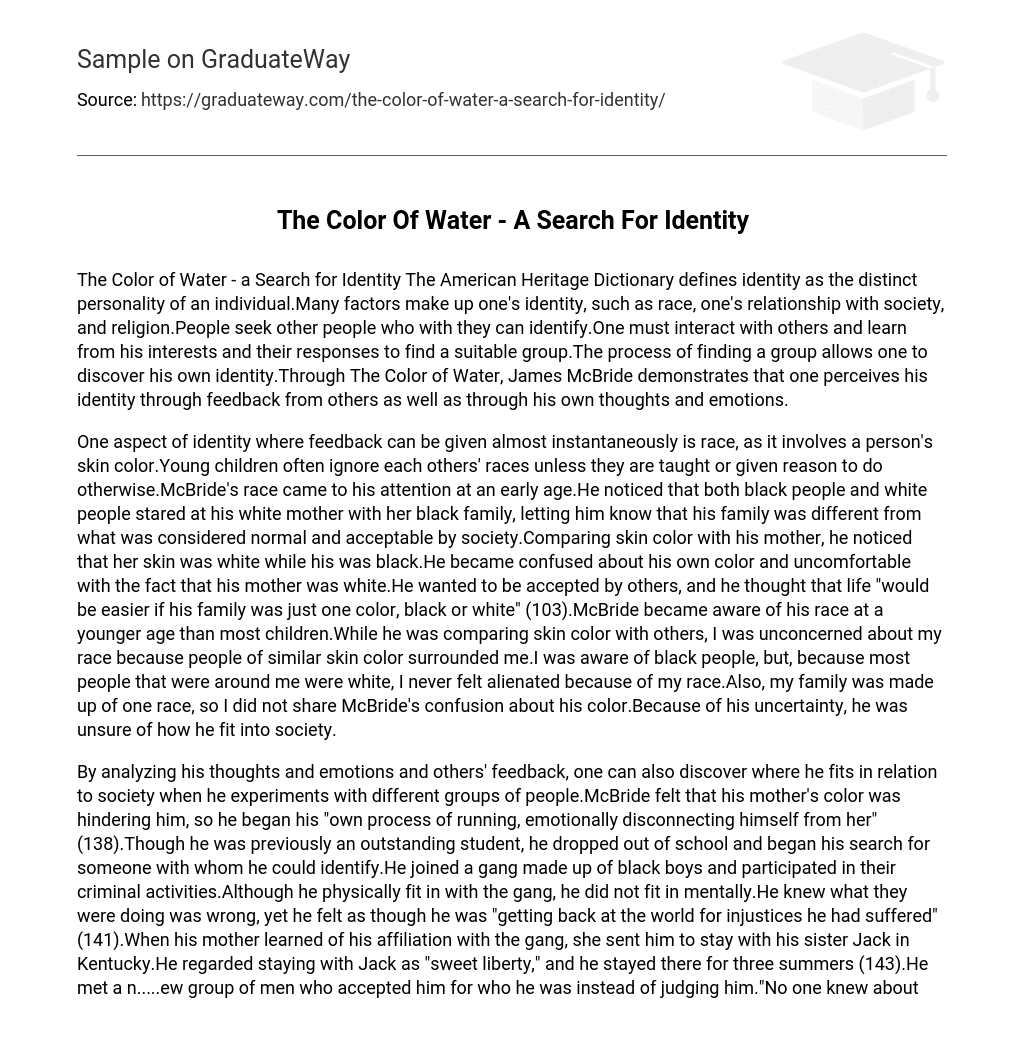The Color of Water – a Search for Identity The American Heritage Dictionary defines identity as the distinct personality of an individual.Many factors make up one’s identity, such as race, one’s relationship with society, and religion.People seek other people who with they can identify.One must interact with others and learn from his interests and their responses to find a suitable group.The process of finding a group allows one to discover his own identity.Through The Color of Water, James McBride demonstrates that one perceives his identity through feedback from others as well as through his own thoughts and emotions.
One aspect of identity where feedback can be given almost instantaneously is race, as it involves a person’s skin color.Young children often ignore each others’ races unless they are taught or given reason to do otherwise.McBride’s race came to his attention at an early age.He noticed that both black people and white people stared at his white mother with her black family, letting him know that his family was different from what was considered normal and acceptable by society.Comparing skin color with his mother, he noticed that her skin was white while his was black.He became confused about his own color and uncomfortable with the fact that his mother was white.He wanted to be accepted by others, and he thought that life “would be easier if his family was just one color, black or white” (103).McBride became aware of his race at a younger age than most children.While he was comparing skin color with others, I was unconcerned about my race because people of similar skin color surrounded me.I was aware of black people, but, because most people that were around me were white, I never felt alienated because of my race.Also, my family was made up of one race, so I did not share McBride’s confusion about his color.Because of his uncertainty, he was unsure of how he fit into society.
By analyzing his thoughts and emotions and others’ feedback, one can also discover where he fits in relation to society when he experiments with different groups of people.McBride felt that his mother’s color was hindering him, so he began his “own process of running, emotionally disconnecting himself from her” (138).Though he was previously an outstanding student, he dropped out of school and began his search for someone with whom he could identify.He joined a gang made up of black boys and participated in their criminal activities.Although he physically fit in with the gang, he did not fit in mentally.He knew what they were doing was wrong, yet he felt as though he was “getting back at the world for injustices he had suffered” (141).When his mother learned of his affiliation with the gang, she sent him to stay with his sister Jack in Kentucky.He regarded staying with Jack as “sweet liberty,” and he stayed there for three summers (143).He met a n…..ew group of men who accepted him for who he was instead of judging him.”No one knew about his past, his white mother, his dead father,” and he felt that he could hide his differences from others (147).
McBride’s experiences in Kentucky taught him about life.The wise Chicken Man discouraged him from abandoning his education and urged him to do whatever he could to succeed in life.Jack told him that if he “put himself in God’s hands” he could not “go wrong” (161).Out of trust, he listened to her and turned to God, and slowly he began to find his way in life.Like McBride, I too experimented with different groups of people in order to find out where I fit in relation to society.I was comfortable with a certain group; we had fun and I fit with them.However, my mother disapproved of the group and made me stay away from them.I then became friends with another group that supported my education and my well-being.I began to exert more effort into my education and horseback riding.Like McBride, I found the group that I fit in with and improved my life.
James McBride’s mother, Ruth, also found a group of supportive people with beliefs that were similar to hers.She relied on her thoughts and emotions and others’ feedback to discover the religious aspect of her identity.Her family was extremely strict in its Jewish beliefs, and her father was an Orthodox rabbi.Because her father forced her to spend her time outside of school working at his store, she became lonely and unhappy. At school, the painful name-calling she received from the other students made her feel further separated from society.With the exception of Frances, she was friendless.Ruth was “starving for love and affection” (83).When she escaped from her religious prison, she sought a new, forgiving religion with which she could identify.She found that she fit in with the Baptist religion.Although she did not blend in with them physically, she matched them in their spiritual beliefs.Unlike Ruth, I am not deeply religious.Most of my friends are not religious, either.Both Ruth and I found groups of people who had beliefs similar to ours, allowing us to identify more easily with our groups.Some of my friends are religious, and sometimes we have trouble understanding each others’ beliefs.However, we still identify with each other because we have other common beliefs or interests, allowing us to feel comfortable with each other.Both Ruth and I have friends that we can identify with in some way.
In The Color of Water, James McBride searches for his identity, as everybody must do in their childhood.One must overcome certain obstacles in order to get to know himself.Only once that he knows himself can he look for other people who are similar to him.Through identifying with other people, he learns about himself. McBride illustrates the process of discovering one’s identity in The Color of Water.





